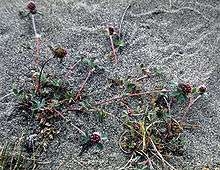Trifolium macraei
| Trifolium macraei | |
|---|---|
 | |
| Scientific classification | |
| Kingdom: | Plantae |
| (unranked): | Angiosperms |
| (unranked): | Eudicots |
| (unranked): | Rosids |
| Order: | Fabales |
| Family: | Fabaceae |
| Subfamily: | Faboideae |
| Tribe: | Trifolieae |
| Genus: | Trifolium |
| Species: | T. macraei |
| Binomial name | |
| Trifolium macraei | |
Trifolium macraei is a species of clover known by the common names Chilean clover,[1] double-head clover, and MacRae's clover. It has a disjunct distribution, occurring on the coastline of Oregon and California in the United States, as well as in South America.[2] It grows in coastal habitat, such as sand dunes, and disturbed areas. It is an annual herb taking a decumbent or erect form. The leaves are made up of oval leaflets 1 to 2 centimeters in length. The inflorescence is usually made up of two oval or rounded heads of flowers each measuring up to 1.5 centimeters wide. Each flower has a calyx of sepals which taper into densely hairy bristles. The flower corolla is purple or bicolored with white or pink.
References
- ↑ "Trifolium macraei". Natural Resources Conservation Service PLANTS Database. USDA. Retrieved 15 December 2015.
- ↑ Knapp, E. E. and P. G. Connors. (1999). Genetic consequences of a single-founder population bottleneck in Trifolium amoenum (Fabaceae). American Journal of Botany 86 124-30.
External links
- Calflora Database: Trifolium macraei (Macrae's clover, Chilean clover)
- Jepson Manual eFlora (TJM2) treatment of Trifolium macraei
- "Trifolium macraei". Germplasm Resources Information Network (GRIN). Agricultural Research Service (ARS), United States Department of Agriculture (USDA).
- UC CalPhotos gallery: Trifolium macraei
This article is issued from
Wikipedia.
The text is licensed under Creative Commons - Attribution - Sharealike.
Additional terms may apply for the media files.